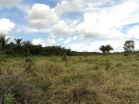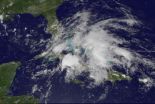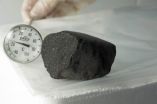According to research to be presented at a global wheat rust symposium in Minneapolis starting June 13, scientists report that variants of the Ug99 strain of stem rust are becoming increasingly virulent and are being carried by wind beyond the handful of countries in East Africa where they had been identified.
New data show that key Ug99 variants have now been identified across all of eastern and southern Africa and that it may only be a matter of time before the spores travel to India or Pakistan, and even Australia and the Americas.
"We are facing the prospect of a biological firestorm, but it's also clear that the research community has responded to the threat at top speed, and we are getting results in the form of new varieties that are resistant to rust and appealing to farmers," said Ronnie Coffman, who heads the Durable Rust Resistance in Wheat (DRRW) project at Cornell University, which is coordinating the fight against the disease. "But the job of science is not over. Declining support for public agricultural research got us into this problem with Ug99. Unless that changes, the problem is likely to arise again in a few years. We are dealing with a constantly-evolving pathogen, and we need to stay at least one step ahead of it at all times."
Coffman and his colleagues note that significant obstacles will have to be overcome before the new varieties of wheat can replace susceptible varieties that cover most of an estimated 225 million hectares of wheat fields throughout the breadbaskets of South Asia, the Middle East, China, Europe, Australia and North America.
"Now it's a question of whether nations are willing to invest the political and economic capital necessary for agricultural research to secure the world's wheat supply," Coffman said.
Norman Borlaug created the Borlaug Global Rust Initiative, or BGRI, in 2005, after confirming that a new stem rust strain called Ug99 could overcome a crucial resistance gene (Sr31) that had been widely used in the world's wheat breeding programs to protect the world's wheat crop from the disease. Borlaug sounded the alarm as only he could. The Nobel Laureate had taken on stem rust in the past, succeeding in breeding high-yielding, rust-resistant wheat in the 1950s and 1960s, after the pathogen had claimed 40 percent of the wheat crop in the US and Canada. Borlaug is credited with saving millions of people from starvation worldwide with rust-resistant varieties that improved yields at the same time.
Up to 90 percent of wheat now in production, including most wheat grown in the Americas, Asia and Africa—is susceptible to Ug99 and its variants. Concern that damage could be inflicted on wheat fields around the world has prompted a vigorous international response spearheaded by the BGRI as scientists contemplate unprecedented losses to a crop that is the main source of sustenance for millions of people.
Researchers at Penn State and the US Department of Agriculture (USDA) are adapting a system that was used to forecast soybean rust movements to track how Ug99 might travel from Africa by winds into the wheat-growing regions of the US.
Strategies for Spurring Introduction of Ug99-Resistant Wheat
The move to protect the world from Ug99 is focused not on creating a single variety of wheat that can withstand the disease, but, rather, on conferring genetic resistance in wheat and transferring these traits to local varieties.
Two factors could accelerate widespread adoption of Ug99-resistant wheat: the rapid spread of yellow rust and the high food prices and grain shortages that have played a role in the political volatility that has roiled the Middle East.
Ravi Singh, a wheat breeding expert at the Mexico-based International Maize and Wheat Improvement Center (known by its Spanish acronym, CIMMYT), and colleagues from the Kenya Agricultural Research Institute, the Ethiopian Institute of Agricultural Research (EIAR) and the USDA will report this week on new varieties of wheat under development at CIMMYT that have resistance to all three rusts of wheat: stem rust, yellow rust and leaf rust. Some of the new varieties yield 10 to 15 percent more than current cultivars.
"We have made tremendous progress on the science side but now we need to see progress on the development side," Singh said. "Scientists can only do so much. We need to see national governments making the investments in seed systems development, including seed production and distribution. In many areas there will need to be support and leadership from wealthy countries and international institutions to carry these innovations into farmers' fields."
New data being presented at the conference will confirm that yellow rust is now common in the world's wheat-growing regions, causing up to 40 percent of losses in countries in the Middle East and Africa, for example.
Scientists from the International Center for Agricultural Research in the Dry Areas (ICARDA) will present new research that shows that yellow rust epidemics have spread rapidly in major wheat-producing regions over the last few years. Yellow rust appears to be adapting to warmer conditions and moving into areas where the disease has not previously caused economic losses.
Scientists see the growing demand for yellow rust-resistant wheat as an opportunity to disseminate new high-yield varieties resistant to multiple pathogens, including yellow rust and stem rust.
For instance, investigators from the EIAR will report that a particularly destructive bout of yellow rust in August 2010 greatly accelerated work in Ethiopia to develop and distribute locally-adapted varieties that had resistance to both yellow and stem rust.
Tracking Ug99
Surveillance data on the spread of Ug99 underscore the urgency of developing and disseminating rust-resistant varieties.
David Hodson, with the Global Cereal Rust Monitoring System at the Food and Agriculture Organization of the United Nations (FAO), will offer an update showing that Ug99 or variants are now confirmed in Uganda, Kenya, Ethiopia, Sudan, Yemen, Iran, Tanzania, South Africa, Zimbabwe, Mozambique and Eritrea. "Future spread of these variants outside of Africa is inevitable," he says.
One source of particular concern is Yemen, where Ug99 is well-established in wheat growing regions and prevailing winds could carry the pathogen towards South Asia. Hodson said there is "good circumstantial evidence" that the stem rust now in Iran—where unfavorable environmental conditions and national containment measures have so far prevented it from causing major problems—drifted some 2,000 kilometers from Yemen.
But Yemen's unrest has presented additional challenges to monitoring and containing the disease and has made it very difficult to deploy resistant wheat varieties. Rust-resistant varieties recently distributed to Yemen from CIMMYT perished in quarantine. However, Hodson noted that, despite difficult conditions, surveillance partners in Yemen recently conducted a comprehensive assessment of a majority of the key wheat-growing areas.
The spores that cause stem rust disease can ride air currents out of Africa to South Asia and, potentially, from southern Africa to Australia as well. They can also hitch a ride unwittingly on infected travelers clothing and cross continents without warning. "I am confidant Ug99 is not in South Asia at the moment but it is really only a matter of time," says Hodson. "When it will arrive and whether it will readily establish itself when it gets there are the very big questions that we cannot yet answer."
Hodson said the good news is that there are now over 20 countries contributing data to the Ug99 surveillance and monitoring system, compared to only two in 2007, with efforts underway to add 10 more. New technologies, like remote sensing, and the use of smart phones to enter and transmit field data, may improve Ug99 tracking in the future.
INFORMATION:
The meeting in St. Paul is part of the Borlaug Global Rust Initiative (BGRI), led by Cornell University, the Mexico-based International Maize and Wheat Improvement Center (CIMMYT), the Food and Agriculture Organization of the United Nations (FAO), the Indian Council of Agricultural Research (ICAR) and the International Center for Agricultural Research in the Dry Areas (ICARDA). For a complete program, including June 13's groundbreaking and field day activities, please see: http://www.globalrust.org/traction/permalink/about218
END





